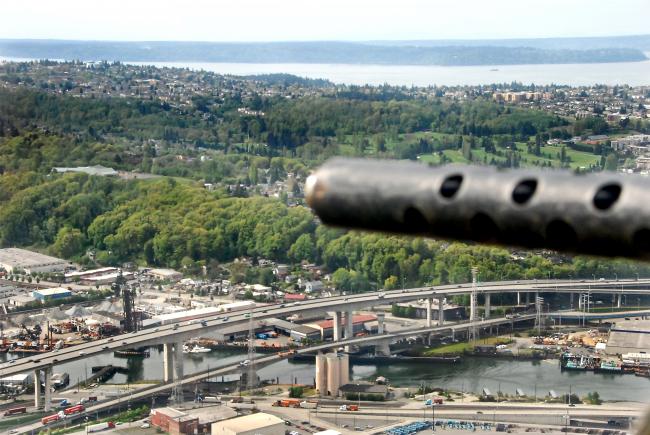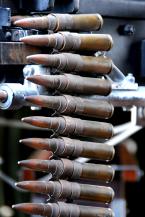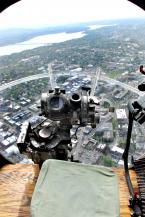SLIDESHOW: B-17 flies over Seattle; Public flights available Apr 24-25
The LIberty Belle will be flying April 24-25 and you can get on board. The flights will be approximately 30 minutes in length. While they are expensive, it's not an experience you will soon forget, and it helps preserve a part of our national heritage.
CLICK THE IMAGE ABOVE TO SEE MORE PHOTOS
Mon, 04/19/2010
Liberty Belle, the most recently restored World War II Boeing B-17 Flying Fortress will take to the skies over Seattle on April 24-25.
Flight hours are 10am to 5pm each day and flights are open to the public. The media was given advance access to the aircraft and our publisher Jerry Robinson, who at 90 was not prepared to take the flight does have some memories to share of his days at Boeing in the story that follows. The Liberty Foundation’s B-17 “Liberty Belle” is one of only 14 B-17’s that still fly today.
CLICK THE IMAGE ABOVE TO SEE MORE PHOTOS
The B-17 dubbed the “Flying Fortress” as a result of her defensive fire power saw action in every theater of operation during WWII. The majority of all WWII B-17’s were operated by the 8th Airforce in Europe and participated in countless missions from bases in England deep into enemy territory. There were 12,732 B-17’s produced between 1935 and 1945, of these 4,735 were lost in combat. Following WWII, the B-17 saw combat in three more wars, B-17’s saw service in Korea, Israel used them in the war of 1948 and was even used during Vietnam.
“Liberty Belle” was built toward the end of the war and never saw any combat. It is painted in the colors and nose art of the original “Liberty Belle” B-17 that flew countless missions with the 390th bomb group of the mighty 8th Airforce. The Liberty Foundation’s B-17G had an interesting post war history. Sold scrap in 1947 to a mining company, in short order it was sold again to Pratt & Whitney for the sum of $2,700.00. Pratt & Whitney operated the B-17 until 1967, in which it was heavily modified test bed for their T-34 & T-64 turbo prop engines thus making it a five engine B-17. In 1968 the B-17 was then donated to the Connecticut Aeronautical Historic society.
Unfortunately, in 1979 the B-17 was heavily damaged in a tornado that threw another airplane onto the B-17’s mid-section breaking her back. The wreck was stored until 1987 when acquired by an aviation enthusiast in Florida with the intent to restore the aircraft. In 1992 the slow laborious task of restoration began and with the turn of the century saw the B-17 sold again to Don Brooks of the Liberty Foundation. Mr. Brooks, whose father flew B-17’s with the 390th bomb group during WWII, founded the Liberty Foundation; a non profit museum dedicated to preserving our aviation heritage, and funded the complete restoration of the B-17 back to her full wartime configuration as she appears today.
He chose to paint the B-17 as the ‘Liberty Belle” as a tribute to his father who was a Tail gunner and flew numerous combat missions in the original Liberty Belle, and all the brave aircrew of WWII. The B-17 following a fourteen year restoration took to the skies again after 38 years on December 8th 2004. The “Liberty Belle” provides visitors the opportunity to take a step back in time and gain respect for the men and women who gave so much to protect our freedoms.
At each stop, flight “missions” are available in the airplane, which allow people to take flights in this historic aircraft. During flight operations, there will be a designated, secure area for those who would like to watch the bomber flight at no charge. For enthusiasts that choose to take a flight experience on this legendary aircraft, these participants receive a pre-flight safety briefing containing the historical significance of the aircraft and a spectacular scenic air tour around the city. During the flight, passengers enjoy the unique opportunity of moving about the aircraft to the different combat crew positions to see the viewpoint that thousands of our heroes saw in combat over 60 years ago.
The total flight experience takes 45 minutes with approximately half hour in flight. Flights experiences are $395 for Liberty Foundation members and $430 for non-members. Passengers can become a Liberty Foundation Member for $40 and receive the member discount for family and friends. While $430 per person sounds expensive, it must be put into perspective when compared to a B-17’s operating cost.
A Flying Fortress costs over $4500 per flight hour and the Liberty Foundation spends over $1,000,000 annually to keep the Liberty Belle airworthy and out on tour. The Liberty Foundation is a 501(c)(3) non-profit flying museum and funds generated help offset these high costs.
What follows is an excerpt from the autobiography of our publisher, Jerrry Robinson called Listen to your father. It is his recollection of his experience working at Boeing during World War II.
Arky and Sparky at Boeing
By Jerry Robinson
I was known as a key employee, though for the life of me I don't know why. As a functional test electrician, my job was to test the electrical circuits on the B17 and B-29s.
As Boeing jobs went, it had its advantages. The best part was the challenge of finding and fixing flaws in the huge airplanes. There were only about twelve two-man crews at the height of the production schedule, so we were hard put to keep up with 30 planes a month. There were some slack times, however. Like when, for one reason or another, we were held up from a task and had to keep out of sight of the foreman. That's when we got in what was known as "flying time:" just sitting in the pilot's seat, gazing out the windshield at the big hangar door. Once, I was piling up some flying time while another crew tested the landing gear. All of a sudden, the airplane felt like it was falling off of its jackstands. I flew, all right. Right out of the cockpit. I raced down the hatch ladder, yelling,“The plane is falling, the plane is falling!” A friend, standing at the base of the ladder, grabbed me and said, “Turkey Lurkey, the plane is not falling. They just raised the hangar door.”
Before you could test electrical circuits you had to get power to the plane's wiring system. This was done with a motor generator that converted 110 AC to 28-volt DC. The motor generator was a huge machine on wheels. You had to push it to the plane, pull the heavy-duty conductor lead from a giant spool and attach it to a bus bar in a wing panel. One day I grabbed the hot wire, put it over my shoulder and climbed up a ladder. I dragged the end of the wire out to the wing tip, and was about to attach the two alligator clamps to the panel, when the lead slipped out of my hands. The weight of the heavy, rubber-insulated wire pulled those hot clamps the entire length of the wing, throwing up a string of sparking explosions, before dropping to the factory floor. What was a poor guy to do? There was a fifty-foot line of spark marks in the top of the wing. I knew it would be hard to explain, so I just moved silently on to another plane.
Then my ubiquitous conscience got to me. I couldn't stand myself, and confessed to the foreman. He was actually pretty kind. He just made me put a burnish on the string of pock marks. There were a lot of inspectors examining it, but they didn't have to throw the wing away. I never made that stupid move again. I just made other stupid moves. In fact, I had a partner working with me. We were known as Arky and Sparky, for good reason.
Another day, Sparky was helping me test the wing flaps on a B-29, out on the flight line. I was up in the cockpit; Sparky, Don Droscher, was outside. We had a small problem. When I flipped the switch up, he'd yell, "They're going down." That was easy. Somebody had wired the switch backward, a simple enough problem. Just reverse the wires. So, while Sparky waited outside, I opened up the pilot's aisle stand, with its maze of switches and wires, and took out two little screws. I was about to attach the wires to their proper locations when there was a sudden July 4th fireworks display. I hadn't bothered to turn the power off to the system, and the aluminum pinky ring on my left hand shorted out the two hot wires. The sparks shot up like a fifty-dollar skyrocket, and the cockpit filled with acrid smoke. My timing was terrible. Just as it happened, my boss's bald head appeared in the open floor hatch.
The warplane scored its first hit with a shower of sparks. The explosion from him exceeded my screw-up, but it was so smoky I knew he couldn't see who was up in the cockpit. Fortunately, the B-29 had a padded tunnel leading to the aft section and I set a world speed record racing on my hands and knees through the tunnel, down a ladder and back up to where the boss was standing, at the front of the plane. "What's the matter, boss?" I asked nonchalantly. "Wow. I don't know," he answered. "You want to take a look?" "Sure, boss," I said, scrambling up the ladder to the scene of my misdeed. As it turned out, it required replacing some wires and switches. It just seemed a lot worse than it turned out to be. But it was the last time I wore a ring on that job.











